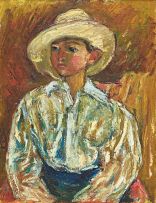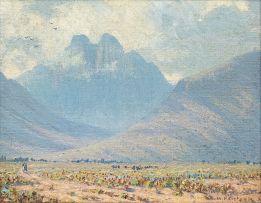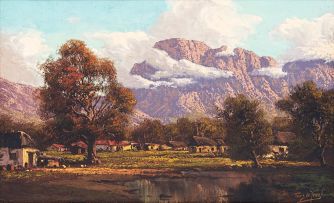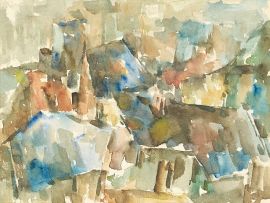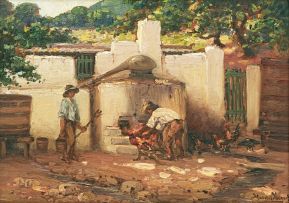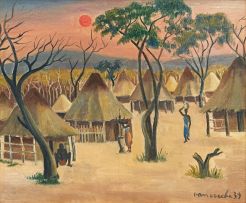Important South African & International Art, Decorative Arts & Jewellery
Live Auction, 16 March 2015
Important South African and International Art Evening Sale
Incl. Buyer's Premium & VAT
About this Item
Notes
Produced toward the end of his itinerant and tragically brief life, this outstanding portrait by Wolf Kibel depicts his son Joseph and is executed in his idiosyncratic expressionist style. While formally significant, especially given Kibel's role in the formation of a local painterly avant-garde during the 1930s, the work is also biographically important. Joseph's "haughty calmness", as Kibel's wife Frieda would later write about this portrait, belies an unseen trauma.1 Born in a shtetl outside Warsaw, Kibel left Poland in 1923 to avoid conscription. He initially settled in Vienna, but in 1925 relocated to Jerusalem, later moving to Tel Aviv, where he met Frieda. Dogged by financial hardship, Kibel immigrated to South Africa in 1929. He arrived alone, his pregnant wife despatched to Warsaw due to visa problems. Kibel's arrival date in Cape Town coincided with the birth of Joseph, who would only come to South Africa three and a half years later with his mother.
Kibel held his first one-man show in Cape Town in 1931. His vigorous and gestural style of painting proved too challenging for local audiences and critics panned his work. "Kibel's exhibitions here were greeted with derision and abuse," remarked Frieda in 1961, adding that her husband endured a "grim battle for existence".2 Artists responded more positively to Kibel. He befriended Lippy Lipshitz, with whom he shared studios and also exhibited, and was encouraged by Hugo Naudé, who became a trusted patron and friend. But it was only after his premature death (from tuberculosis) that Kibel's significance became the subject of active rehabilitation.
In 1946 critic David Lewis singled Kibel out as a "profound experimentalist" in his provocative study of post-union South African art.3 Walter Battiss, who along with Lipshitz was a founding member of the New Group, ranked Kibel alongside Irma Stern and Maggie Laubser as a "pioneering" expressionist and similarly praised his painterly innovations.4 A 1950 survey exhibition at the South African National Gallery in Cape Town played an important role in shifting public perceptions. Commercially, Kibel's star also began to rise, Jean Welz introducing a selling exhibition of his work at the Lidchi Gallery in 1962. Reporting on the exhibition, News/Check, a current affairs magazine where Robert Hodgins worked as a staffer at the time, remarked on his "exaggerated colour-contrasts and hallucinatory distortions" and described him as an "eloquent talent".5 Other notable admirers of Kibel's work included Neville Dubow, who in 1968 co-authored a monograph with Frieda, and Wopko Jensma, who mentions Kibel by name in a 1977 poem.
In a letter written to Lipshitz shortly after Kibel's death, Naudé, while mournful of the loss, nonetheless expressed doubt whether Kibel "really had a real chance to prove his philosophies about art".6 This portrait demonstrates Kibel's remarkable virtuosity with domestic scenes, especially portraits. While the influence of Soutine is clear, particularly in his rich colour palette and thick impasto brushwork, the work claims a more immediate affinity: Kibel's well-known self-portrait. Like that key work, which appears on the cover of his 1968 monograph, Kibel here has clearly managed to distil his influences and focus his vigorous painterly energies. The result is a powerful portrait of a young boy raffishly posing for his father that also expresses all of Kibel's philosophies about art.
1. Kibel, Frieda (1961) 'Wolf Kibel', in Our Art, Vol. 2, Pretoria: SA Association for the Advancement of Knowledge and Culture. Page 68.
2. Ibid., page 67.
3. Lewis, David (1946) The Naked Eye, Cape Town: Paul Koston. Page 17.
4. Battiss, Walter Battiss (1957) 'The Last Bushman Artists', in The Studio, Vol. 153, London: Studio Trust. Page 68.
5. -- (1963) 'The Lonely Road', in News/Check, 12 April. Page 37.
6. Naudé, Adèle (1974) Hugo Naudé, Cape Town: S. Struik Publishers. Page 14.
Exhibited
South African National Gallery, Cape Town, and Pretoria Art Museum, Wolf Kibel Retrospective, 1976, catalogue number 32
Literature
Freda Kibel. (1961) Our Art 2: Wolf Kibel, Pretoria: Foundation for Education, Science and Technology. Page 68 and illustrated on page 69, number III.
This work blends interest in the personality of the sitter with a rich play of colour and texture. Paint is used vigorously to create restless texture throughout the painting except in the face, which is smooth. This surrounding texture, which reaches its peak in the shirt, serves to create a restless mood echoing the inner tension of the sitter, so well disguised by the apparent, almost haughty calmness of his facial expression, a calmness further heightened by the comparative smoothness with which the face itself is painted.
A.C. Bouman. (1955) Painters of South Africa, Cape Town: HAUM h/a J. H. De Bussy. Page 133, illustrated.
The 'Portrait of His Son' is as much a revelling in paint and colour as it is the loving representation of an intelligent and nervous child.
F.L. Alexander. (1962) Art in South Africa: Painting Sculpture and Graphic Work since 1900. Cape Town: AA Balkema. Page 48 and illustrated in colour on page 49.

